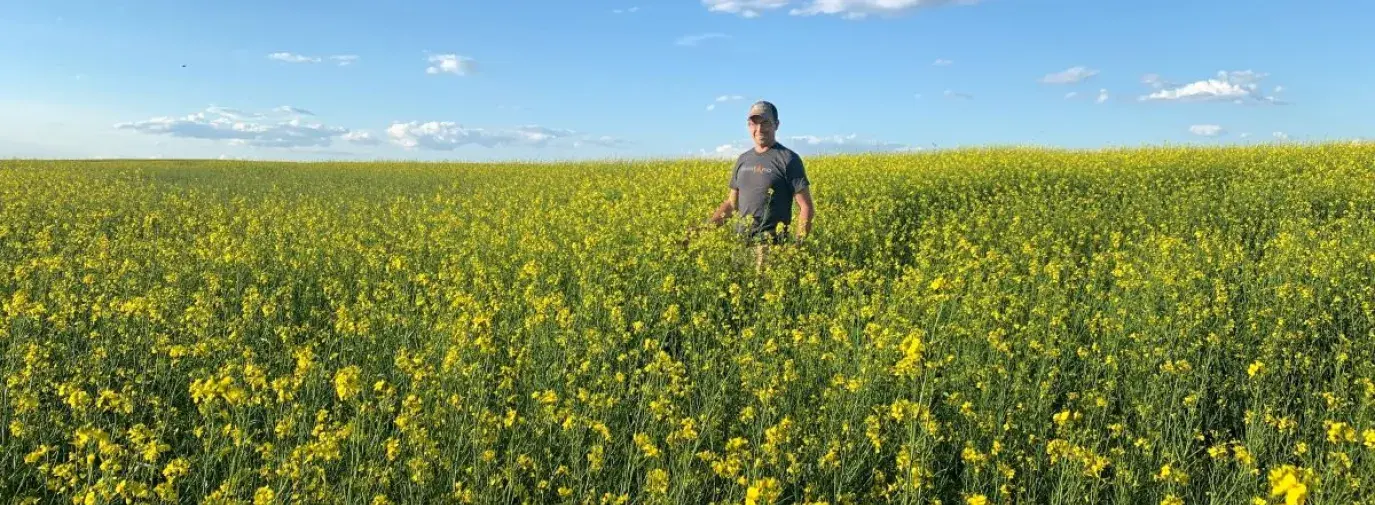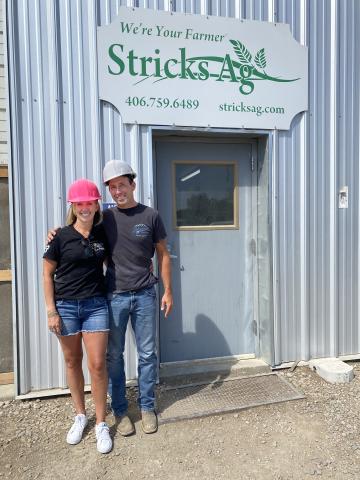
Under expansive blue skies and rolling grass plains in Chester, Montana, a certain farm is modeling healthy relationships among the producers, distributors, and land. Tyler Streit is a fifth-generation farmer, who used to monocrop wheat across his family’s 20,000 acres, about the size of Manhattan. Today, with his wife Jill Streit, they grow 19 different crop varieties, follow regenerative agriculture practices, and model communicative relationships throughout the agricultural supply chain.
The Regenerative Transition
Historically, the Streits farm followed industrial agriculture norms: applying synthetic fertilizers, spraying chemicals to keep out weeds and pests, and plowing fields every year. They didn’t realize that this process killed nearly all the microorganisms in the soil—only leaving about half a percent, Tyler estimates. Organic matter is important for moisture retention, nutrients, and carbon sequestration. Healthy soil has roughly 2-8% organic matter, according to the University of Minnesota, as well as abundant underground biological activity, such as from fungi and earthworms.
“We’ve built some of that organic matter up to 3%. Our goal is to have it at 5%,” says Tyler.
In the early 90s, Tyler’s father Leonard decided to try a no-till program and Tyler and Jill started diversifying their crops in the early 2000s. Adding pulses to their crop rotation—chickpeas, peas, and lentils—helped to create healthier soil. These plants fix atmospheric nitrogen into the soil, which is an essential nutrient for plants to grow, and thus reduces the need for synthetic fertilizers.
The farm has been using primarily its own saved seeds for years. Sowing seeds from previous generations is crucial to climate resiliency since each generation becomes coded with important environmental information to survive the next year and the year after that. In the last few years, the Streit farm has also eliminated synthetic seed treatments (treated seeds have chemicals or other synthetic materials applied to the outside to boost their ability to grow) and fungicides from all their fields.
The farm is totally different today than how it was when Tyler’s parents and grandparents ran it, he says.
“Now it’s a transition of the mindset to not just producing, but how we produce,” Jill adds. “Our challenge is to figure out the best way to work within the ecosystem, to regenerate the soil and be able to produce things that have more nutrition.”
A Network to Promote the Producers
When the Streits started growing pulses, a type of legume, they realized quickly that the markets to sell these plants were small in Montana, so they decided to create a place to process and sell locally. They took a leap of faith and started a pulse-processing facility in 2014 with the Wicks family, creating a new business called Stricks Ag.
“We risked a lot and started working in that space where we were actually buying products, not only from ourselves, but from other producers, packaging them and selling them out into the market space,” says Jill.
The presence of the facility has given local farmers the opportunity to add pulses to their field rotations and plug into the Streits’ network to sell their products. Altogether, the Streits have influenced 300 producers to add pulses to their farms.
While the facility has helped farmers diversify their crops, it’s also given Jill and Tyler the opportunity to share what they’ve learned about regenerative farming. They host weekly growers meetings in the winter, as well as additional meetings and field days throughout the year to teach other farmers their knowledge.

The pulse-processing facility opened lots of doors for Tyler and Jill as communicators and network-builders among chickpea farmers and buyers, including Banza, a company that makes products like pasta, pizza, and mac & cheese out of chickpeas, and is part of Green America Soil Carbon Initiative’s Go-To-Market Pilot. Tyler and Jill are also part of the Pilot, which gives them a place to tout the benefits of regenerative farming and prove the value of regenerative food with the SCI label.
Genuine Connection
Banza was introduced to Tyler in 2017 through the Redwood Group, which is a commodity supply chain partner with a large network of farmers. Banza representatives immediately recognized that the Streits were unlike other farmers: committed to soil health and the well-being of producers.
The relationship that Banza and the Streits have formed is unlike many in the industry, where farmers often don’t get to have a relationship with the end manufacturer or customer. Tyler and Jill spend a lot of time communicating with manufacturers like Banza so companies are aware of the state of the farms and the ebbs and flows of chickpea yields and prices.
Sophie Rifkin, senior director of sustainability at Banza, says that Banza values the hard work and partnership of growers like Jill and Tyler who are open to improving soil health because it supports their focus to improve sustainability in their supply chain.
“What it has done is created more stability in their manufacturing, [because Banza is prepared for low yield years,] and it has created more stability in our ability to produce the products, knowing that we have a marketplace to go to,” says Jill. “Every time I see a box of Banza on the shelf, I have pride. As a producer, that’s great to know that our products are in that box feeding the world a healthier product.”
Additionally, Green America’s Soil Carbon Initiative opens new pathways for Banza and the Streits as they continue to grow sustainable and regenerative practices throughout their operations. “When Banza first learned about the SCI program and decided to join the pilot, we immediately thought of partnering with Jill and Tyler,” says Rifkin. “These types of collaborations are needed to help advance new ways of farming.”
With the network they’ve established, through SCI and in their community, the Streits hope to share their story so that buyers recognize the importance of regenerative chickpeas and inspire other farmers to adopt regenerative farming practices.
“If we can get growers to make a few little changes, we can make a big impact [on the environment],” says Jill. “An a-ha moment was not just that we could do it on our own farm, but that if we all did it, the difference it would make.”







